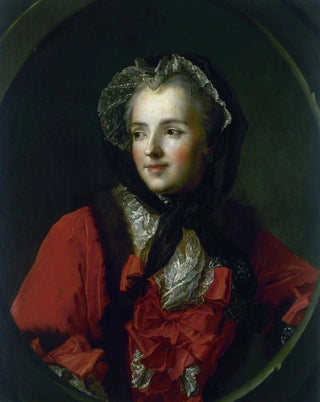Art print | Portrait of Marie Leszczynska, Queen of France - Jean-Marc Nattier Source: Reproduction | Portrait de Marie Leszczynska Reine de France - Jean-Marc Nattier


View from behind

Frame (optional)
Portrait of Marie Leszczynska, Queen of France - Jean-Marc Nattier – Captivating Introduction
The "Portrait of Marie Leszczynska, Queen of France" by Jean-Marc Nattier is an iconic work from the 18th century, showcasing the elegance and sophistication of the Rococo era. Capturing the grace of the queen, this painting is much more than a simple representation; it embodies the very essence of a time when art and royalty intertwined harmoniously. Marie Leszczynska, wife of Louis XV, is depicted not only as a sovereign but also as an insightful woman, whose personality shines through in the meticulous details and stylistic choices of Nattier. This portrait, with its delicate colors and subtle lighting, invites the viewer to immerse themselves in the refined universe of the French court.
Style and uniqueness of the work
Nattier's style is distinguished by his masterful use of light and shadow, creating an intimate and warm atmosphere. In this piece, the queen is portrayed in a natural pose, surrounded by sumptuous drapery that highlights her stature and dignity. The pastel tones, typical of Rococo, add softness to the overall composition, while ornamental details, such as sparkling jewelry and rich fabrics, emphasize Marie Leszczynska's royal status. Nattier excels in rendering textures, making the lightness of silk and the shine of precious metals almost tangible. This portrait, with its harmonious composition and attention to detail, stands out as a flagship work, revealing not only the beauty of the queen but also the artist's technical skill.
The artist and his influence
Jean-Marc Nattier, one of the most renowned portraitists of his time, was able to capture the spirit of his era through his works. Trained at the Royal Academy of Painting and Sculpture, he quickly gained fame thanks to his exceptional talent for immortalizing court figures. Nattier managed to blend tradition and innovation, incorporating elements of Baroque while moving towards a lighter, more decorative style. His influence extends well beyond his own

Matte finish

View from behind

Frame (optional)
Portrait of Marie Leszczynska, Queen of France - Jean-Marc Nattier – Captivating Introduction
The "Portrait of Marie Leszczynska, Queen of France" by Jean-Marc Nattier is an iconic work from the 18th century, showcasing the elegance and sophistication of the Rococo era. Capturing the grace of the queen, this painting is much more than a simple representation; it embodies the very essence of a time when art and royalty intertwined harmoniously. Marie Leszczynska, wife of Louis XV, is depicted not only as a sovereign but also as an insightful woman, whose personality shines through in the meticulous details and stylistic choices of Nattier. This portrait, with its delicate colors and subtle lighting, invites the viewer to immerse themselves in the refined universe of the French court.
Style and uniqueness of the work
Nattier's style is distinguished by his masterful use of light and shadow, creating an intimate and warm atmosphere. In this piece, the queen is portrayed in a natural pose, surrounded by sumptuous drapery that highlights her stature and dignity. The pastel tones, typical of Rococo, add softness to the overall composition, while ornamental details, such as sparkling jewelry and rich fabrics, emphasize Marie Leszczynska's royal status. Nattier excels in rendering textures, making the lightness of silk and the shine of precious metals almost tangible. This portrait, with its harmonious composition and attention to detail, stands out as a flagship work, revealing not only the beauty of the queen but also the artist's technical skill.
The artist and his influence
Jean-Marc Nattier, one of the most renowned portraitists of his time, was able to capture the spirit of his era through his works. Trained at the Royal Academy of Painting and Sculpture, he quickly gained fame thanks to his exceptional talent for immortalizing court figures. Nattier managed to blend tradition and innovation, incorporating elements of Baroque while moving towards a lighter, more decorative style. His influence extends well beyond his own






